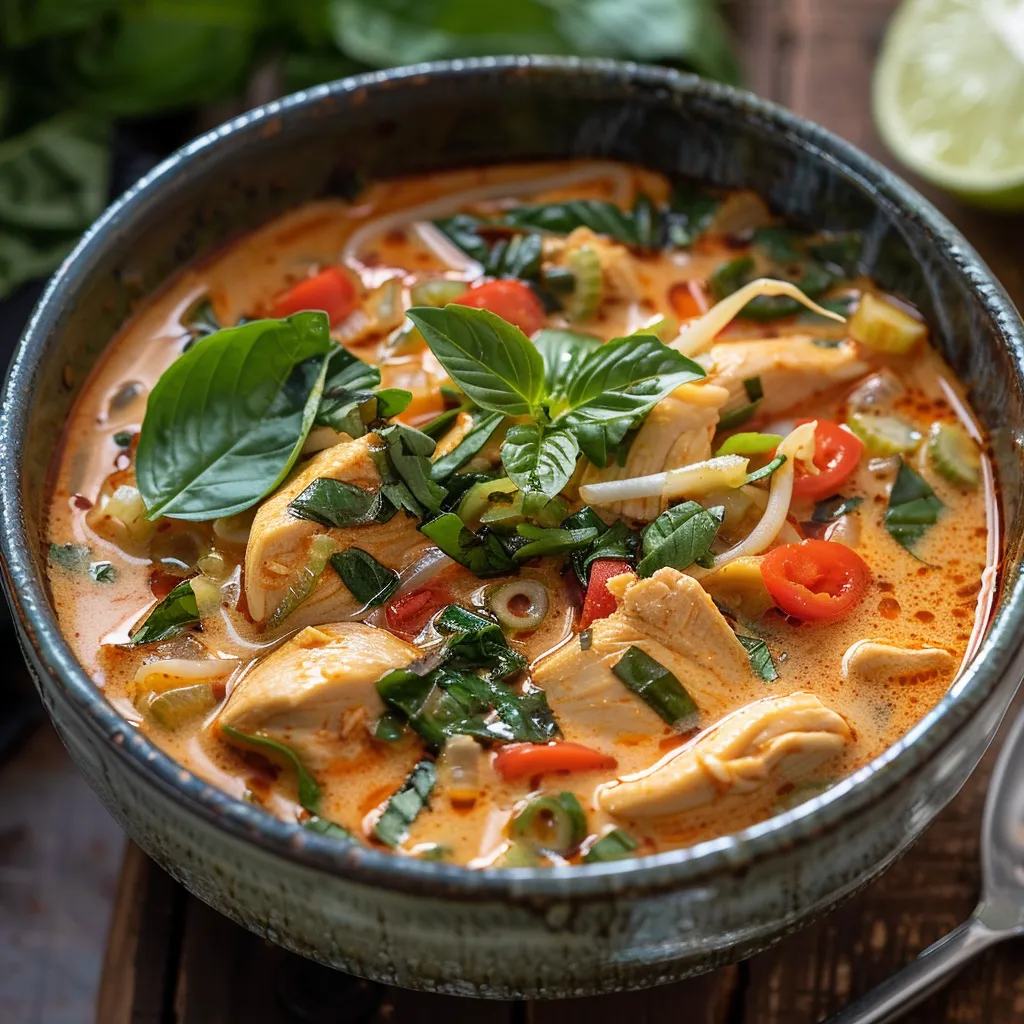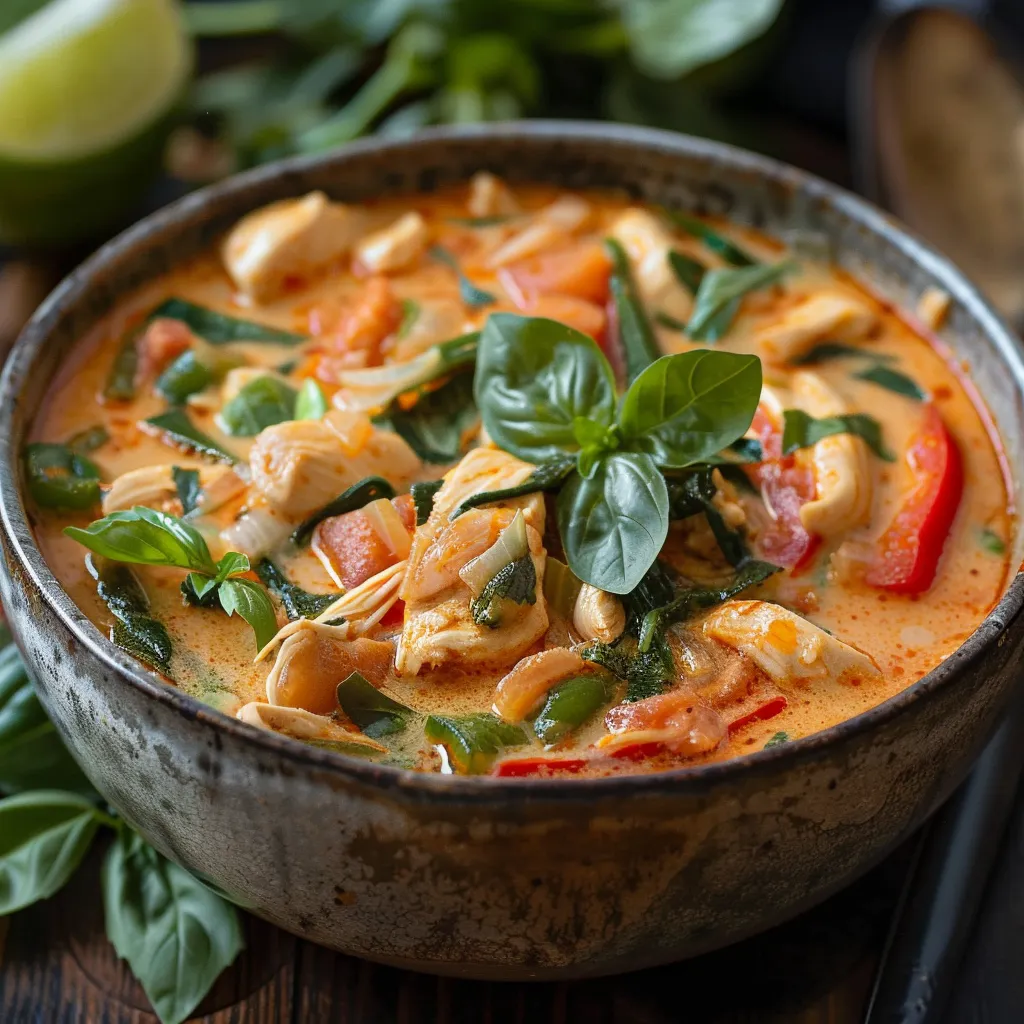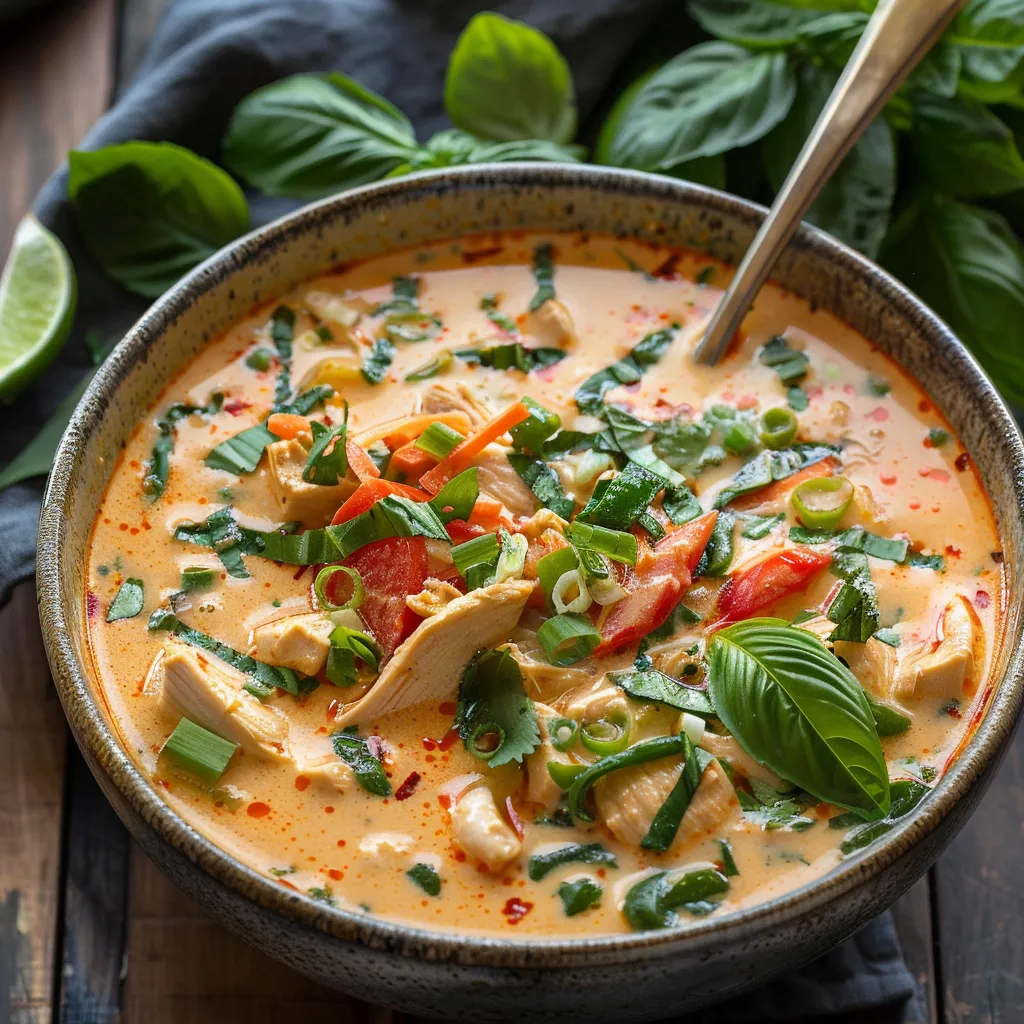 Pin it
Pin it
This fusion soup blends cozy homestyle chicken broth with bold Thai flavors. The creamy coconut base meets zesty curry paste, creating a mouthwatering mix of heat, sweetness and tang surrounding juicy chicken chunks and crisp veggies.
I whipped up this soup during a stormy afternoon when we couldn't get delivery but I was dying for some Thai flavors. It's now become our go-to Monday dinner after hectic weekends when we need something both satisfying and exciting.
Ingredients
- Boneless skinless chicken breasts: they soak up all the curry goodness while staying juicy and tender
- Avocado oil: works great for cooking at high heat without adding any odd tastes
- Sweet onion: adds a mild sweetness that cuts through the spice – grab ones that feel solid with no mushy areas
- Red bell pepper: brings beautiful color and a sweet crunch – look for ones that seem heavy when you pick them up
- Carrots: give natural sweetness and nice bite – go for bright, firm ones without any cracks
- Mushrooms: add a meaty texture and earthy flavor – choose firm caps with dry surfaces
- Garlic and ginger: make up the flavor backbone – fresh ones give the best punch
- Red curry paste: the key ingredient that brings all that spicy complexity – check for real Thai ingredients on the package
- Coconut milk: creates that smooth, velvety base – give the can a good shake before you open it
- Chicken broth: adds depth to the flavor – homemade is fantastic but good store brands work too
- Rice noodles: soak up all that tasty broth and keep the dish gluten-free
- Fish sauce: brings that can't-miss umami punch – don't mind the smell, it works magic when cooked
- Lime juice: adds that crucial tang – always go with freshly squeezed
Step-by-Step Instructions
- Season and Sear Chicken:
- Sprinkle salt and pepper on your chicken chunks first to build a good flavor foundation. When you cook them, don't crowd the pan or they'll steam instead of brown. You want that golden color for extra taste. Cook just until they're lightly browned for about 4-5 minutes – they'll finish cooking in the soup later.
- Sauté the Vegetables:
- This step builds all the base flavors as your veggies soften and release their natural sweetness. Don't rush it – wait for those onions to turn see-through and the peppers to soften slightly. Your carrots and mushrooms will start releasing their juices, which makes their flavors stronger. This usually takes around 4-5 minutes on medium heat. Just stir now and then so everything cooks evenly.
- Build the Aromatic Base:
- Throwing in garlic, ginger and curry paste creates the soul of your soup. Cook them just until you can smell them – about 30-60 seconds – which lets out their essential oils without burning them. This quick but crucial step turns the curry paste from raw to aromatic and blends all those fragrant ingredients together for that classic Thai flavor.
- Create the Broth:
- Pour in your coconut milk and chicken broth while scraping the pot bottom to get all those tasty bits mixed in. Adding sugar helps balance the curry's heat. Let everything come to a gentle bubble so the flavors start mingling. Your broth should turn a pretty orange color as the curry paste fully melts in.
- Cook Everything Together:
- Put the chicken back in along with the rice noodles so everything can finish cooking together. The noodles will drink up the tasty broth while the chicken finishes cooking to perfect tenderness. Stir once in a while so the noodles don't stick to each other. Your soup is done when the veggies are tender, the chicken is fully cooked, and the noodles are soft but still have a bit of chew.
- Final Seasoning:
- Add fish sauce and lime juice after taking the pot off the heat. This keeps their flavors bright while cutting through the coconut milk's richness. This last touch gives you that real Thai taste, adding the perfect salty-sour notes to balance the creamy, spicy broth. Taste and maybe add more lime juice if needed – you want a nice mix of sweet, spicy, savory and tangy flavors.
 Pin it
Pin it
The red curry paste really makes this soup stand out. I found out how different grocery store brands are from authentic Thai versions during a cooking class in Chicago. The teacher told us that real Thai curry paste has galangal, lemongrass and makrut lime, creating that complex flavor you just can't get with substitutes. Now I always keep a few tubs in my freezer for soup emergencies.
Noodle Know-How
Rice noodles need special care to turn out just right in this soup. They cook way faster than wheat pasta and keep softening even after you turn off the heat. For best results, add them during the last 10 minutes of cooking time. Don't worry if they seem a little firm when you taste them – they'll keep soaking up liquid and getting softer as the soup sits. If you're making this ahead, think about cooking and storing the noodles separately, adding them only when you reheat so they don't turn mushy.
Smart Substitutions
You can easily tweak this recipe based on what's in your kitchen. Chicken thighs work great instead of breasts and give even more flavor and juiciness. If you don't eat meat, just skip the chicken and throw in extra mushrooms or cubed tofu for protein. You can swap any veggies – snow peas, baby corn or bok choy all work well. No coconut milk? Unsweetened cashew cream gives a similar richness, though it'll change the flavor a bit. Green or yellow curry paste can take the place of red for different but equally tasty results.
Freezer Friendly Tips
This Thai curry soup freezes surprisingly well, unlike many creamy soups – if you do it right. For best results, freeze it without the noodles or fresh herbs. Let it cool completely before putting it in freezer containers, leaving some room at the top for expansion. It'll keep for up to three months. When you're ready to eat it, thaw overnight in the fridge then warm it gently on the stove. Cook fresh rice noodles separately and toss them into the hot soup with fresh herbs and a squeeze of lime right before serving.
Serving Suggestions
Make this soup part of a complete Thai feast with some simple sides. A basic cucumber salad with rice vinegar and a touch of sugar gives a cool contrast to the warm, spicy soup. Fresh spring rolls with peanut dipping sauce work as a light starter that won't fill you up before the main course. For a bigger meal, serve smaller soup portions alongside Thai sticky rice or coconut rice to soak up that flavorful broth. Always put extra lime wedges, fresh herbs and thin-sliced chili peppers on the table so everyone can fix their bowl just how they like it.
 Pin it
Pin it
Frequently Asked Questions
- → Could I swap chicken for another protein?
Absolutely! Shrimp, tofu, or thinly sliced beef all work great. Just watch the cooking times to get it just right.
- → What’s a good replacement for red curry paste?
If you’re out of red curry paste, yellow paste gives a milder flavor, while green adds more heat. Adjust the amount to your liking!
- → How do I make it vegan or vegetarian?
Skip the chicken and go for tofu or more veggies. Swap chicken broth with vegetable broth, and check your curry paste and condiments to ensure they're vegan-friendly.
- → Can I cook this soup in advance?
Sure! Keep it in a sealed container in the fridge for up to 3 days. Reheat on the stove or in the microwave, and add a little broth if it feels too thick.
- → How do I make the spice level milder or spicier?
To tone down the heat, use less red curry paste. For an extra kick, add more or mix in a spicier curry paste like green. Play around to suit your taste.
- → What herbs go best with this dish?
Cilantro, Thai basil, and scallions are top-notch choices. They add a fresh and flavorful boost to the soup.
